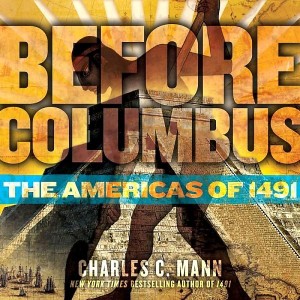Jul
2011
Before Columbus: The Americas of 1491 by Charles C. Mann
 It turns out almost everything I learned about early US History was wrong. Squanto–actually Tisquantum–was not just a friendly Indian who helped the Pilgrims plant corn and survive the winter. The “New World” was not a vast untamed wilderness, either. The civilizations that filled North and South America were much larger, far older, and more complex than historians realized.
It turns out almost everything I learned about early US History was wrong. Squanto–actually Tisquantum–was not just a friendly Indian who helped the Pilgrims plant corn and survive the winter. The “New World” was not a vast untamed wilderness, either. The civilizations that filled North and South America were much larger, far older, and more complex than historians realized.
Maybe history doesn’t change, but our understanding of it sure does. Charles C. Mann journeys through those places long ago and far away to reveal a clearer picture of what life may have been like in Before Columbus: The Americans of 1491 (Scholastic 2009). Historians and archaeologists hotly debate which version of history is accurate, and this book raises those interesting questions.
If more nonfiction was written in such an engaging manner as this is, I’d definitely become a fan. In fact, I’ve already read excerpts of 1491 (the grown up version) on Mann’s website and want more. This YA version is packed with pictures and photos as well as astounding facts and stories. Sidebars raise–and offer possible answers–to intriguing questions such as Too Many Mummies? or Why No Wheels?
Mann starts with one of the best-known stories our our country’s beginnings–the Pilgrims–and explains why the simple school version is not nearly enough. The real deal is much more interesting as well, whether Mann is exploring the history of the Pilgrims or the Maya or Inca or other ancient civilizations. This book goes well with one of last year’s Young Hoosier nominees: Who Was First: Discovering the Americas by Russell Freedman.
[…] var acmSettings = { capture_clicks: 1, query_id:'40', click_precision: 1, group_points: 3, point_size: 5, box_size: 3, rel_precision: 5, ajax_url: 'http://thanksgiving-2011.net/', inner_text_max_length: 64, max_intensity: 0.9, min_intensity: 0.3 }; #split {}#single {}#splitalign {margin-left: auto; margin-right: auto;}#singlealign {margin-left: auto; margin-right: auto;}.linkboxtext {line-height: 1.4em;}.linkboxcontainer {padding: 7px 7px 7px 7px;background-color:#eeeeee;border-color:#000000;border-width:0px; border-style:solid;}.linkboxdisplay {padding: 7px 7px 7px 7px;}.linkboxdisplay td {text-align: center;}.linkboxdisplay a:link {text-decoration: none;}.linkboxdisplay a:hover {text-decoration: underline;} function opensingledropdown() { document.getElementById('singletablelinks').style.display = ''; document.getElementById('singlemouse').style.display = 'none'; } function closesingledropdown() { document.getElementById('singletablelinks').style.display = 'none'; document.getElementById('singlemouse').style.display = ''; } History of Thanksgiving DayHistory of ThanksgivingThe First Real Thanksgiving : Robin’s BlogSemi HomemadeTrivia Quiz for Thanksgiving – Twenty Question US History Trivia QuizCypris Chat | Blog | NEWSLETTER: Volume III Issue 5 August/September 2011Giving Thanks: Thanksgiving Recipes and History, from Pilgrims to Pumpkin PieSpice Up Your Thanksgiving Day Turkey DinnerHolidaying outside the eurozone offers good value for money – Private YachtBefore Columbus: The Americas of 1491 by Charles C. Mann – Mrs. McGriff’s Reading Blog […]